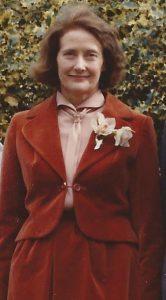
Dr.Mary Macdonald was educated at Perth Academy where she excelled academically and also in athletics as a sprinter, the latter as a result purely of natural talent unaccompanied by any enthusiasm for sport, save for cricket.
Having initially considered and then rejected a career in astronomy, she decided on a career in Medicine entering Edinburgh University in 1940 and graduating in 1945. Mary did, however, retain a lifelong interest in astronomy. After a year as House Officer in Edinburgh she was appointed Assistant Lecturer in the University Department of Pathology in Edinburgh where she spent most of her working life thereafter. She became a member of the Royal College of Physicians of Edinburgh in 1948 and was married to Dr. James S Robson that year. The following year they were both awarded Rockefeller Travelling Fellowships at Harvard where she continued her training in pathology.
In the early 1950’s, Dr. Robson who had developed a special interest in renal medicine, performed Edinburgh’s first percutaneous renal biopsy shortly after the introduction of this technique. The tiny samples so obtained were sent, naturally, to Dr. Macdonald for diagnosis. Happily she had access to an electron microscope and also a little later to immunofluorescence microscopy and these methods had a profound effect on the understanding of the lesions of glomerular disease as well as tubulo-interstitial lesions. Dr. Macdonald soon mastered these methods of examination and rapidly acquired a national and then international reputation for her abilities as a renal pathologist. Quite quickly the accumulation of new knowledge resulted in new entities being described, such as mesangial IgA nephropathy, resulting in a completely new classification of glomerulonephritis in particular and a growing understanding of both aetiology and pathogenesis and ultimately evidence that the pathological findings could allow for more accurate prognostic comment in individual cases as well as indications for appropriate treatment. She was involved, at an early stage, in the recognition of intraglomerular coagulation and the role this played in glomerular inflammation.
Dr. Robson and Dr. Macdonald played an important role in the establishment of the Medical Research Council trials in the treatment of glomerulonephritis. She was instrumental in bringing together renal pathologists from throughout the United Kingdom to agree a common terminology to describe glomerular lesions and so paved the way for effective multi-centre pathological and clinical studies.
When the first renal transplant in the U.K. was carried out in Edinburgh by Sir Michael Woodruff in 1960, her interpretation of needle biopsy of the transplant played an important role in recognizing the causes of graft failure allowing the appropriate corrective measures to be undertaken.
Dr. Macdonald published a large number of original articles in peer-reviewed journals and was the author of numerous chapters in many major textbooks. Her skills as an editor led to her involvement in some later editions of Davidson’s The Principles and Practice of Medicine and a similar role in Robson and Passmore’s A Companion to Medical Studies, a three volume work published in 1968 with later editions in 1970 and 1974. She had an outstanding grasp of language which she attributed to her Perth Academy education. This resulted in her ability to make all the many publications she authored or co-authored more concise and crystal clear – she would not tolerate any poorly constructed sentences or grammatical errors, the apostrophe had to be correctly used. Her many colleagues and students owe her a debt of gratitude for her rigorous pursuit of excellence in the written word.
She conducted research in several areas of renal pathology using animal models in a small number of instances. She acted a supervisor for graduates in pursuit of further qualifications, both M.D. and Ph.D.
Dr. Macdonald was a very fine lecturer and tutor and endeared herself by her kind and compassionate manner, to many generations of students. She took particular interest in the development of the Hons.B.Sc. degree as an intercalated year after 2nd MB for selected students. The imaginative research projects she offered meant that she was a popular choice of supervisor every year. She ensured they received endless encouragement both in carrying out the practical work but also in presenting their theses on completion. Many would attest to this year as bringing a sea-change in their appreciation of life as an undergraduate and this is attested in that there are at least seven of her protégés currently holding chairs in such fields as Pathology, Nephrology and Medicine. In addition she was particularly supportive of undergraduate and post-graduate female students encouraging those who married to continue practicing under their maiden name.
Dr Macdonald was thus an early pioneer in the field of nephrology, particularly nephropathology. She charted new areas such as the histological changes of transplant rejection; she pioneered newe techniques such as electron microscopy and immunofluorescence microscopy; she encouraged and supported many undergraduate students and national and international postgraduate students in their research activities whilst retaining a modest and unassuming attitude to her own significant achievements.
Away from work, she led an equally busy life taking great care of the welfare of her two sons making sure there was always time for a normal family life for both the highs and the lows. They were keen supporters of Glasgow Rangers and she took them frequently to Ibrox Park to watch their heroes in action, occasionally using this time to correct paper proofs. She had a particularly keen sense of humour. As a Methodist she had a deep religious belief and worshipped in The Central Hall at Tollcross where she took Sunday School and was also an important member of the choir till she retired aged 86. Her fine voice she said was a gift from her mother who had been a professional singer. Latterly she looked after Professor Robson through several years of declining health in their home, till shortly before his death in 2010.